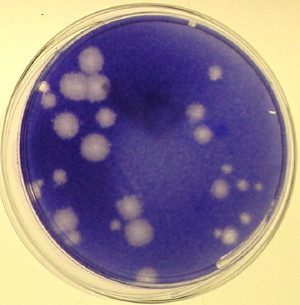

To produce the movies, cells were infected with vaccinia virus, covered with a semi-solid medium, and placed in an incubator. The monolayers were examined periodically until a small plaque became visible. The infected cells were then placed on an inverted microscope fitted with a camera. Images of the plaque were taken every hour for 12-19 hours and assembled into a movie.
The first movie shows plaque formation on monkey cells infected with vaccinia virus. The virus infection begins at a small focus in the center, then spreads radially outwards. As the infection spreads, the cells undergo changes know as cytopathic effect. The large circle of dead cells would appear as a plaque if the monolayer were stained.
The second movie, made at higher magnification, shows spread at the edge of a viral plaque. The vaccinia virus used for this experiment carries the gene encoding enhanced green fluorescent protein (EGFP). Hence the infected cells fluoresce green as viral replication proceeds.
By showing very clearly how a viral plaque develops, these movies will be an invaluable teaching resource for years to come. I am grateful to the authors of this study for providing an up-close view of a technique that animal virologists have been using since 1952.
Doceul, V., Hollinshead, M., van der Linden, L., & Smith, G. (2010). Repulsion of Superinfecting Virions: A Mechanism for Rapid Virus Spread Science DOI: 10.1126/science.1183173

Pingback: uberVU - social comments
Incredible. It seems miraculous to me that we can actually WATCH this happening. Thanks for posting this, Vincent.
Have a look on this article and mainly on supplemental material, video S3A (http://www.ncbi.nlm.nih.gov/pmc/articles/PMC216…) It shows how syncytia induced by measles virus develop and move (survive) as long as new fresh cells are added.
However, the rules that permit the formation of a syncytium are yet to be found (and it is not that easy) : is there a threshold of surface proteins in order to establish syncytia, in which direction…?
Fascinating; the outward spread looks like a shock wave and I'm trying to understand why that is so.
Beautiful on the one hand, frightening on the other. As long as this is what happens in humans who get infected with certain viruses I tend to the latter. It is time to put more effort into virology.
As the cells are killed by viral infection, their refraction changes
and that appears as a shock wave in the microscope.
I'm looking for a link to a list describing the different methods of virus-growth
(“passage”) and their abbreviations (E2,C1,M,P0,
I'm looking for a link to a list describing the different methods of virus-growth
(“passage”) and their abbreviations (E2,C1,M,P0,
Great job!